
(Library of Congress)
It’s one of the more familiar aspects of Margaret “Unsinkable Molly” Brown’s account of her escape from the sinking Titanic. She claimed she was walking along the deck when two burly men picked her up and tossed her into a lifeboat — a dramatic detail that’s never questioned. Surely, Mrs. Brown’s survival must have been epic; simply stepping into a boat wouldn’t do for such a feisty lady. Right?
Another tall tale
Tough-talking Colorado millionairess Margaret Tobin Brown, 45, was a character. We sense it from her immodest claims, and we know it from the Hollywood version of her exploits. Margaret never failed to share stirring tales of adventure when relating events of her life, and she never stopped others from expounding on them. Making it off Titanic was no exception; it was, in fact, the story she most often embellished.
Columnist Cholly Knickerbocker recalled that Margaret bombarded Newport society circles with her stories of escape from the shipwreck to such an extent that she became known as “Mrs. Titanic Brown.”1 Margaret claimed she was in one of the last lifeboats together with Madeleine Astor and Eleanor Widener. Not true. She said she “used an oar herself and made the other women do the same to keep them from freezing to death.”2 Again, not exactly true. So what about this allegedly athletic departure from the ship? Was she really thrown into a lifeboat by others trying to save her life? Or might this be another exaggeration?
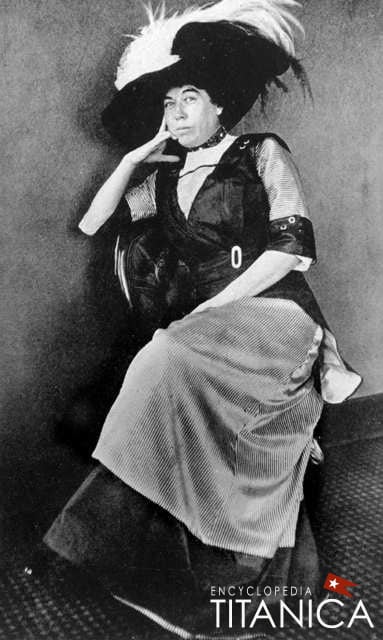
(Colorado Historical Society)
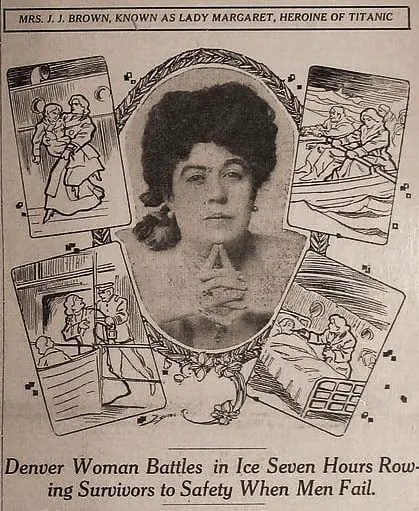
Did they even know each other?
Who were the men who supposedly rescued Margaret Brown? She named names: they were Edward Calderhead, 42, and James McGough, 35, she said. They were not only fellow First Class passengers on Titanic but occupied cabins across the corridor from Margaret’s stateroom on E-Deck. Margaret was in E-23, McGough, a 6’2” Gimbel’s (New York) Department Store buyer, was in E-25, and Calderhead, also a Gimbels buyer, was next door to McGough in E-243 McGough was sharing his room with yet another Gimbel’s buying representative, J. I. (John Irwin) Flynn, 36, and Calderhead shared his with a buyer for Nugent’s Department Store in St. Louis, Spencer Silverthorne, 35.4 The merchants were all enjoying a rest after concluding their European business trips for the spring season.
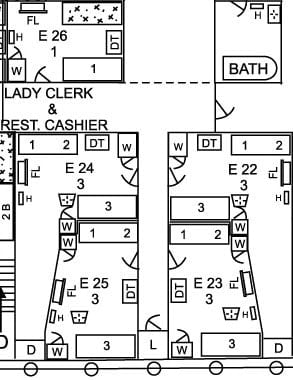
The men didn’t know Margaret Brown personally, but they probably encountered the buxom, talkative lady over the previous four days since setting sail from France. On the night of April 14th, they almost certainly spoke to her; at least McGough did.
Eager to visit her son and his wife in America, having learned their infant son (her grandson) was ill, globetrotting Margaret had boarded the Titanic at Cherbourg, leaving her daughter at school in Paris.5 Margaret had been reading in bed when the collision happened with the berg at around 11:40 p.m. Margaret got up and, in her nightdress, opened the door of her cabin to investigate. She saw the Gimbel’s men already in the hallway, wearing pyjamas, having also been dismayed by the unusual sensation. The men, Margaret later told the Newport Herald, were chafing each other. One of them remarked, “Are you prepared to swim in those things?” referring to the pyjamas. Women were standing along the corridors in their kimonos. All seemed to be quietly listening, thinking nothing serious had occurred, though realizing at the time that the engines had stopped immediately after the crash and the boat was at a standstill.6
Margaret thought it was only some minor disturbance and returned to her bunk to resume reading. But hearing excited voices in the stateroom next door, she got up again. The women in the other cabin were silent film actress Dorothy Gibson, 22, and her mother, Pauline, 45. “We will go on deck and see what has happened,” one said to the other.7
Margaret again peered out into the corridor, located just off the bank of elevators, and wondered what could be the trouble everyone was so concerned about. One of the ladies in a dressing gown that Margaret must have seen was standing almost opposite her own cabin. Assigned to E-26, she was 31-year-old Mabel Francatelli, nicknamed “Franks,” personal assistant to fashion designer “Lucile” (Lady Duff Gordon), also en route.8
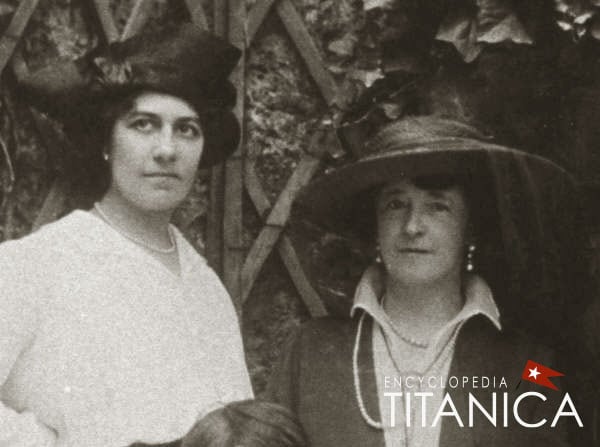
(Randy Bryan Bigham)
While standing at her door looking around, one of the Gimbel’s buyers came up to Margaret. To her, his “face was blanched, his eyes protruding, wearing the look of a haunted creature.” It was James McGough, poking his head out of the stateroom across the way. Worried after hearing from a steward that lifebelts had been ordered, he told her to dress warmly and put her “life-saver” on.9
McGough later related their encounter to the U. S. Senate Inquiry, saying
I rapped on the door of the stateroom opposite mine which was occupied by a lady and suggested to her that she had better get up at once and dress as there was apparently something wrong.10
Margaret was shocked, having seen no steward, but quickly complied. Donning the black velvet outfit again and the sable stole she had worn to dinner that night, Margaret added a silk hat and carried her lifebelt with her as she mounted the stairs to A Deck.
There, she noticed about 50 people waiting in the grand staircase foyer. As she laced on her lifebelt, one of her travelling companions approached her. “Didn’t I tell you something was going to happen?”11 Emma Bucknell, 58, said to Margaret. Bucknell, who accompanied Brown when she boarded at Cherbourg, demurred about taking the ship. Brown had dismissed her friend’s premonition.
The two soon exited the vestibule on the port side of the Boat Deck, one level above A Deck, stepping out into the cold night air.
Soon, they heard the order from a ship’s officer to go below to board a lifeboat, No. 4, which had been lowered to A Deck. But Margaret didn’t follow those instructions, instead helping others when crewmen began to prepare the next boat, No. 6.
How it might have taken place
At about the time Margaret reached the Boat Deck with Emma Bucknell, her E-Deck neighbors McGough and Calderhead came out on deck as well. In McGough’s account, he claimed only that he was on the starboard Boat Deck. Yet in Margaret’s story, she said she saw the two Gimbel’s men near her on port at Lifeboat 6.
As Emma and her maid entered Boat 8, Margaret started assisting several other women aboard No. 6. Both boats had been lowered flush with the deck for easier access and were loading simultaneously. One of the women at Boat 6, a young French lady, had become excitable, and Margaret had to calm her down, convincing her not to return to her cabin to retrieve her jewelry. She was Belgian music hall performer Berthe Mayné, 24 (on the passenger list, she appeared as “Mrs B. de Villiers”).12

(Randy Bryan Bigham)
Margaret had just put Mayné in No. 6 and walked aft, stepping up onto the nearby raised roof of the lounge to gain a better view of the proceedings.
As she claimed in a syndicated interview later:
I had noticed two men following me from place to place as I talked to the women here and there. These two men just then followed me to the upper deck and carried me down and practically threw me into the boat with the words, ‘You are going, too.’13
She was even more descriptive in her Newport Herald story:
I was walking away, eager to see what was being done with the boats on the other side, not fearing any immediate danger, thinking if the worst should happen I could swim out. Suddenly, I saw a shadow and a few seconds later I was being taken hold of…I was dropped fully four feet into the lowering boat.14
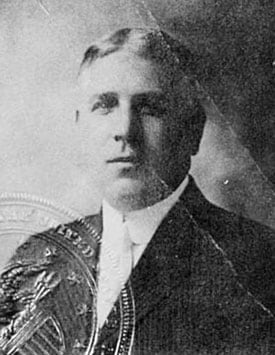
(National Archives / Encyclopedia-Titanica)
Was there even time?
As related above, James McGough never attested to being one of the men who placed Margaret Brown in Boat 6. He never even said he was on the port side of Titanic’s Boat Deck during the emergency. His supposed companion, Edward Calderhead, also never claimed to have assisted in the effort to save Margaret. If the other store buyers, J. I. Flynn or Spencer Silverthorne were the heroic pair, they never admitted to being Margaret’s saviours, either. Flynn, who was tall like McGough, did recall her being in a stateroom near his on E-Deck. Whoever the men were, they did not come forward following her much-publicized commendation.
There is actually no corroboration of her claim that the Gimbel’s buyers plopped her into a boat at all on Titanic’s port side. There is also the inconvenient fact of the starboard side lifeboat launchings. The men are known to have been aboard two of those boats, Nos. 5 and 7, which departed the ship well before port Boat 6 was lowered.
Boats 5 and 7 were the first two lifeboats launched during the evacuation, leaving the starboard Boat Deck at about 12:40 a.m. (for No. 7) and 12:43-45 a.m. (for No. 5). Boat 6 could not even have started loading on the opposite (port) side of the ship before 12:40 a.m., according to Titanic expert Samuel Halpern, author of Report into the Loss of the SS Titanic and other authoritative texts on the disaster.15
That Margaret claimed her boat, No. 6, was already lowering when she was thrown into it stretches her tale’s credibility further. Boat 6 is believed by some to have not begun lowering until 12:55 a.m. Even though others say No. 6 didn’t start down its falls until 1:10 a.m., it doesn’t matter. Both times are too late for the Gimbel’s buyers to have aided her and still have managed to escape in the boats that are known to have saved them.16

(National Archives / Encyclopedia-Titanica)
A well-intentioned lie
While it’s possible Margaret misidentified the men she said forced her into a lifeboat that famous morning, it’s more likely, given her tendency to embroider the truth, that she merely hoped to bolster the reputations of these men who’d done her a good turn after the collision by alerting her to the danger. Many men in the wake of the sinking had to justify their very survival because of the widespread misunderstanding that they had been forbidden in lifeboats, a rule actually enacted only on the port side of the Boat Deck during the accident. Margaret’s white lie may not have been needed, but it’s in keeping with her big-hearted largesse that she offered to stand up for the men.
Margaret ran into McGough and Calderhead on the rescue ship Carpathia and it may have been then that a chance to be of service to them occurred to her. When they told her they “felt extremely embarrassed” among the female survivors who’d lost husbands or sons, Margaret had the good grace to assure them that she “was living evidence of their thoughtfulness to womankind,” referring to the men’s warning to her about Titanic’s condition.17 It isn’t known when their solicitous consideration on E-Deck morphed into chivalrous bravery by dropping her into a lifeboat, but the outsized story fits the depth of her gratitude to the Gimbel’s buyers. As Margaret claimed in an interview later, “I owe my life to them.”18
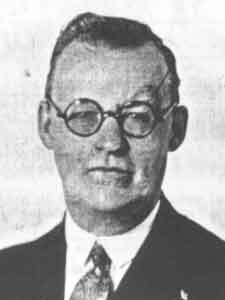
(National Archive / Encyclopedia-Titanica)
What happened afterwards?
Whoever dropped Margaret Brown into Boat 6 (if anyone did), the lifeboat made it safely away from the Titanic after first getting held up along C-Deck. That was when it was discovered there weren’t enough crewmen aboard to handle it once afloat properly. A First Class passenger, yachtsman Maj. Arthur Peuchen, 52, volunteered, and he slid down the falls to fill in for the crew. The people in No. 6, numbering about 25, rowed most of the morning for the elusive light on the horizon; this was believed to be the Californian, stopped in the ice floes some 13 miles away. When the Titanic went down, women in Boat 6 wished to return to save the drowning, but Quartermaster Robert Hichens, 29, refused, citing the danger of such a proposition. Margaret did indeed help row that morning, but she wasn’t the taskmaster she claimed to be by ordering the other women to row, too. The occupants of No. 6 included several other highly motivated, strong-willed women who didn’t need to be corralled into service; they were more than competent to lead and duly prepared to assist. Boat 6 soon tied up to another lifeboat, No. 16, and was later picked up by Carpathia at about 8 a.m.
James McGough said in his affidavit before the U.S. Senate investigation that he came up to the starboard Boat Deck after the iceberg collision; he never claimed he was on the port side at any time. Col. Archibald Gracie listed him as being in Boat 7 in his book The Truth About the Titanic (1913). McGough, in his testimony, said an officer told him at the time, “Here, you are a big fellow, get into the boat.”19 Only about 28 men and women boarded No. 7. It later tied up to No. 5, which saved the two other Gimbel’s men, Flynn and Calderhead, as well as Calderhead’s roommate, Silverthorne. Boat 5 held about 36 passengers and crew. The boats reached Carpathia between 6 a.m. and 6:15 a.m. So far as is known, after meeting up with Margaret briefly on the rescue ship, the buyers never saw their benefactress again.

(National Archives / Encyclopedia-Titanica)
Notes
- Paul, Maury (Cholly Knickerbocker), “How yodel cost rich Mrs Brown place in society,” Pittsburgh Sun-Telegraph, April 27, 1941.
- “Heroine of the Titanic wreck,” Scranton Truth, April 22, 1912. Thanks to Mike Poirier.
- Biographical entries (McGough, Calderhead, Flynn, Silverthorne), Encyclopedia-Titanica.org; Klistorner, Daniel, “Molly Brown: Mystery Unraveled,” Encyclopedia-Titanica.org, Aug. 28, 2003.
- Biographical entries (McGough, Calderhead, Flynn, Silverthorne), Encyclopedia-Titanica.org.
- Iversen, Kristen, Molly Brown: Unraveling the myth, Boulder, Colo.: Johnson Books, 1999, p. 2.
- Brown, Margaret (Mrs. J. J.), “The sailing of the Ill-fated steamship Titanic,” Newport Herald, May 28, 29 and 30, 1912.
- Ibid.
- Author’s correspondence (2004) with Daniel Klistorner who explained that Francatelli’s cabin was likely E-26 and not E-36 as printed in the stewards’ known passenger manifest.
- Brown, Margaret (Mrs. J. J.), “The sailing of the Ill-fated steamship Titanic,” Newport Herald, May 28, 1912.
- James McGough, affidavit, Titanic Inquiry, U. S. Senate, May 1, 1912.
- Brown, Margaret (Mrs. J. J.), “The sailing of the Ill-fated steamship Titanic,” Newport Herald, May 28, 1912.
- Geller, Judith, Titanic: Women and Children First, New York: W. W. Norton, pp. 52-56. Thanks to Daniel Klistorner for sharing a copy of the “Cave list” stewards’ manifest.
- “Heroine of the Titanic wreck,” Scranton Truth, April 22, 1912. Thanks to Mike Poirier.
- Brown, Margaret (Mrs. J. J.), “The sailing of the Ill-fated steamship Titanic,” Newport Herald, May 28, 1912.
- Author’s correspondence (2022) with Samuel Halpern.
- New evidence of lifeboat launch times shared with the author by Ioannis Georgiou and Samuel Halpern; Fitch, Tad., et al, On a Sea of Glass, Gloucestershire, UK: The History Press, 2015, p. 196.
- Brown, Margaret (Mrs. J. J.), “The sailing of the Ill-fated steamship Titanic,” Newport Herald, May 30, 1912.
- “Heroine of the Titanic wreck,” Scranton Truth, April 22, 1912. Thanks to Mike Poirier.
- James McGough, affidavit, Titanic Inquiry, U. S. Senate, May 1, 1912.
Acknowledgements
Thanks to Mike Poirier for alerting me to the extraordinary, however unlikely, story of Margaret, the Gimbel’s buyers and Boat 6. Thanks also to Samuel Halpern for his advice, to Gregg Jasper for his editorial guidance.

Comment and discuss